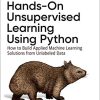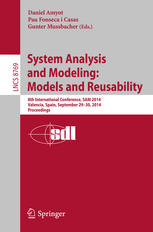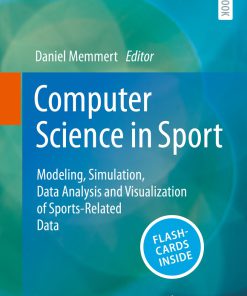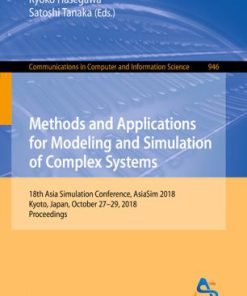Advances in Simulation and Digital Human Modeling 1st Edition by Daniel Cassenti, Sofia Scataglini, Sudhakar Rajulu, Julia Wright ISBN 3030510646 9783030510640
$50.00 Original price was: $50.00.$25.00Current price is: $25.00.
Advances in Simulation and Digital Human Modeling 1st Edition BY Daniel N Cassenti, Sofia Scataglini, Sudhakar L. Rajulu, Julia L. Wright – Ebook PDF Instant Download/Delivery: 3030510646, 978- 3030510640
Full download Advances in Simulation and Digital Human Modeling 1st Edition after payment
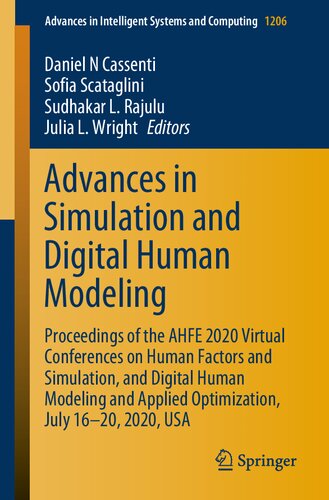
Product details:
ISBN 10: 3030510646
ISBN 13: 978-3030510640
Author: Daniel N Cassenti, Sofia Scataglini, Sudhakar L. Rajulu, Julia L. Wright
This book presents the latest advances in modeling and simulation for human factors research. It reports on cutting-edge simulators such as virtual and augmented reality, multisensory environments, and modeling and simulation methods used in various applications, including surgery, military operations, occupational safety, sports training, education, transportation and robotics. Based on two AHFE 2020 Virtual Conferences such as the AHFE 2020 Virtual Conference on Human Factors and Simulation and the AHFE 2020 Virtual Conference on Digital Human Modeling and Applied Optimization, held on July 16–20, 2020, the book serves as a timely reference guide for researchers and practitioners developing new modeling and simulation tools for analyzing or improving human performance. It also offers a unique resource for modelers seeking insights into human factors research and more feasible and reliable computational tools to foster advances in this exciting field.
Advances in Simulation and Digital Human Modeling 1st Table of contents:
Human Factors and Simulated Agents
- Trustworthy Human-Centered Automation Through Explainable AI and High-Fidelity Simulation: Exploring how explainable AI and simulation can improve human trust in automation.
- Conducting Polyphonic Human-Robot Communication: Mastering Crescendos and Diminuendos in Transparency: Focusing on the transparency of human-robot communication, particularly in complex or nuanced interactions.
- An Extended Framework for Context Modeling: A framework for modeling the context in human-machine interactions to improve system performance.
- Human-Machine Interaction Efficiency Factors in Flight Simulator Training Towards Chinese Pilots: Investigating the factors that influence human-machine interaction in flight simulators, particularly for Chinese pilots.
Training and Simulation
- Utilizing Simulation to Train Decision Making with Conflicting Information: Training individuals to make decisions under conflicting or incomplete information using simulation techniques.
- Considerations in Adding Adaptive Training to Existing Virtual Environments: How adaptive training can be incorporated into current virtual environments to improve learning outcomes.
- Evoking Stress Reactivity in a Virtual Dance Competition: Using virtual environments to evoke stress and analyze its impact on performance.
- Visualizing Quantitative Uncertainty: A Review of Common Approaches, Current Limitations, and Use Cases: A review of methods for visualizing uncertainty in simulations, highlighting challenges and potential applications.
Socio-Political Modeling
- Negotiating an Inefficient Market: An Agent-Based Model Approach to Property Insurance Claim Negotiations: Applying agent-based modeling to simulate and optimize property insurance claim negotiations.
- Hidden Markov Models for Visual Processing of Marketing Leaflets: Using hidden Markov models to analyze and optimize marketing strategies through visual processing.
- Overcoming Inconvenience: How Society Can Incentivize Individual Recycling Behavior; An Agent-Based Model: Developing models to understand and promote individual recycling behaviors in society.
- Identifying New Team Trust and Team Cohesion Metrics that Support Future Human-Autonomy Teams: A study on how to measure team trust and cohesion for future human-autonomy collaboration.
Driving Simulators
- Psychophysiological Predictors of Motion Sickness in the Driving Simulator: Analyzing the physiological factors that predict motion sickness during driving simulations.
- Characterizing Driver Workload and Attention in a Simulated Automated Vehicle: Exploring how workload and attention levels affect drivers interacting with autonomous vehicles.
- Comparative Analysis to the Performance of Three Mobile Ad-Hoc Network Routing Protocols in Time-Critical Events of Search and Rescue Missions: A comparison of communication protocols used in search and rescue mission simulations.
- The Two-Level Complex of Traffic Behavior Assessment Focused on Driving Skills in the Context of Autonomous Driving: A complex evaluation of traffic behaviors and driving skills, particularly in autonomous vehicle settings.
- Validation of Immersive Design Parameters in Driving Simulation Environments: Validating the design parameters of driving simulators for better immersion and realism.
- Driving Simulator Validation of Machine Learning Classification for a Surface Electromyography-Based Steering Assistance Interface: Using driving simulators to validate machine learning techniques for controlling steering assistance interfaces via surface electromyography.
- Building Narrative Scenarios for Human-Autonomous Vehicle Interaction Research in Simulators: Developing realistic narrative scenarios to study human-autonomous vehicle interactions in simulators.
Healthcare and Occupational Safety
- Gamification of Hazards Recognition in Mining with a Tabletop Card Game: Using gamification to train workers in hazard recognition in mining environments.
- Simulation-Based Safety Training for Plant Maintenance in Virtual Reality: Utilizing VR-based simulations to train workers in plant maintenance and safety protocols.
- Biomechanical Modeling and 3D Simulation of Firefighting Tasks: 3D modeling and simulations of firefighting tasks to assess physical demands and improve safety training.
Perceptual and Cognitive Processes
- Tangible VR Multi-user Simulation Methodology for a Balanced Human System Integration: Developing a multi-user VR methodology for better human-system integration.
- MiNDesign: Toward a Modeling, Simulation and Evaluation Platform for Human Cognitive Performance: A platform for modeling and evaluating human cognitive performance in different scenarios.
- Perception of Terrain Slope in Real and Virtual Environments: A study on how humans perceive terrain slope in both real and virtual settings.
- Digital Human Modeling by Women: Exploring the specific design issues and user needs of female participants in digital human modeling.
- An Exploratory Analysis of User Needs and Design Issues of Wearable Technology for Monitoring Running Performances: Investigating how wearable technology can be designed to monitor running performances.
- How to Enhance Aging People’s Wellness by Means of Human-Centered and Co-design Methodology: Using human-centered and co-design methods to improve wellness for aging populations.
- Potentials and Limitations in the Application of Virtual Ergonomics: A Review of Empirical Studies: Reviewing the use of virtual ergonomics to design better workspaces and assess human performance.
- SOOMA – New Developments on Automation of Digital Model Cleaning: Advances in automating digital model cleaning, particularly in the context of ergonomics and human modeling.
- Analysis of Surface Segments Deviations Between Different Female Body Types Based on 3D Flattening Method: Studying the surface segment deviations in digital models based on body type differences.
Motion Capture and Analysis
- The Correlation Between Frontal Area and Joint Angles During Cycling: Investigating how cycling efficiency correlates with the cyclist’s body position and joint movements.
- Goalkeeper’s Performances Assessed with Action Cameras Based Mocap System: Using motion capture technology to assess a goalkeeper’s performance in sports.
- A New Assessment for Monitoring Performance in Pianists: A system for monitoring and evaluating the performance of pianists using motion capture technology.
- Evaluation of Golden Gait Approximation Using Smart Clothing: Analyzing gait dynamics and performance using smart clothing embedded with sensors.
- Female Torso Shape Classification: Methods and Comparison: Classifying different female torso shapes using motion capture and 3D modeling techniques.
- 3D Anthropometry, Shape Modeling, and Applied Optimization: Using 3D anthropometry to model body shapes and optimize designs for various applications.
- Online Management and Query of Multimodal Human Motion and Shape Data: A platform for managing and querying multimodal motion and shape data.
- Dimension Reduction of Anthropometric Measurements with Support Vector Machine for Regression: Application to a French Military Personnel Database: Using machine learning to reduce the dimensionality of anthropometric data for military applications.
- A Methodology to Create 3D Body Models in Motion: A methodology for creating accurate 3D models of body motion for various industries.
- How the Artificial Neural Network Solves the Muscle Redundancy Problem During Pedaling Motion?: Using artificial neural networks to address the problem of muscle redundancy in cycling motion analysis.
Comfort, Perception, and Cognitive Modeling
- Extraordinary Automated Driving Situations: Probabilistic Analytical Modeling of Human-Systems-Integration (HSI) and the Role of Trust: Analyzing how trust in automated systems influences human-system interaction during extraordinary driving situations.
- An Experimental Investigation of Preferred Seat Pressure Distribution: Investigating how seat pressure distribution affects comfort and performance in vehicles.
- Robust Markerless 3D Head Tracking of a Vehicle Occupant Using OpenPose: Using markerless 3D head tracking to study vehicle occupant behavior and comfort.
- Cognitive Load and Stress Assessment of Medical High-Fidelity Simulations for Emergency Management: Measuring cognitive load and stress during medical simulation training for emergency management.
People also search for Advances in Simulation and Digital Human Modeling 1st :
advances in simulation journal
benefits and challenges of simulation technology as a technology trend
digital simulations and models
human simulation software
advances in simulation impact factor
Tags:
Daniel Cassenti,Sofia Scataglini,Sudhakar Rajulu,Julia Wright,Advances,Simulation,Digital Human,Modeling 1st
You may also like…
Computers
Interactive Modeling and Simulation in Business System Design 1st Edition Ella Roubtsova (Auth.)
Computers - Programming
Computers - Computer Science


